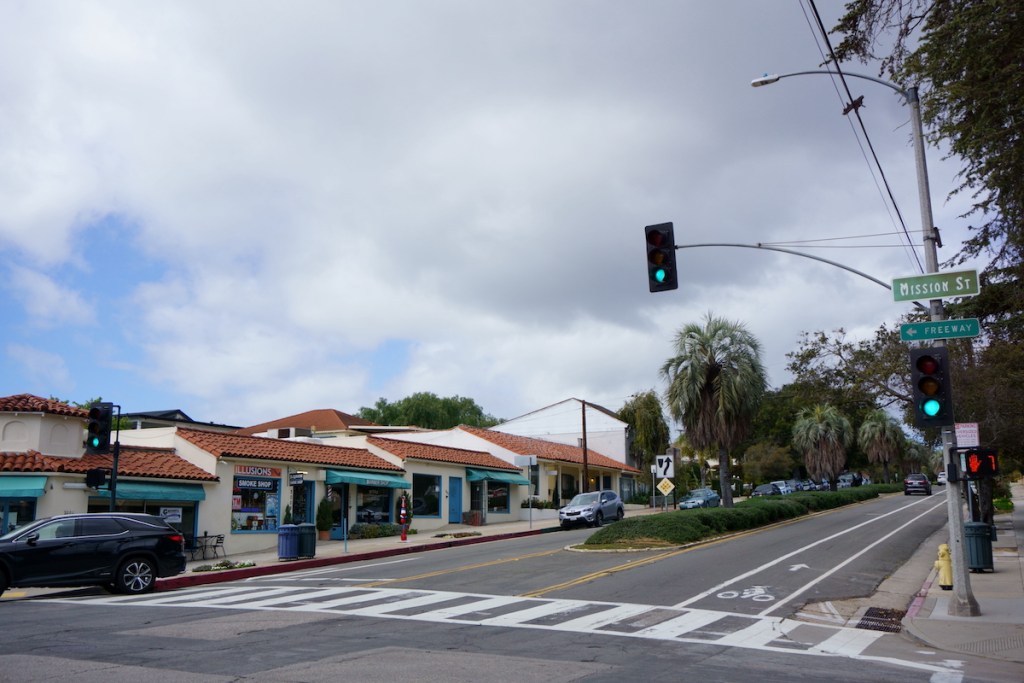The State Street Parkway, which spans the center median of downtown Santa Barbara’s main street from Mission Street to Constance Avenue, was designated as a historic landmark in a unanimous decision by the City Council on Tuesday.
The parkway, including its hardy landscaping and iconic stout-trunk pindo palm trees, was nominated to receive historic landmark designation by the Upper East Association last year and received support from neighbors and community organizations due to the location’s connection to the early-20th-century urban-planning era known as the “City Beautiful” movement.
Architectural Historian Nicole Hernandez presented a report to the council detailing the historical significance of the parkways. She began with an image showing the area in 1898, when the surrounding properties were almost all agricultural and State Street was “just a little street running through the orchards.”
Just a few years later, Hernandez said, the strip had already been subdivided into residential areas, with the first two houses being built in 1915 and Flying A Studios taking up a large lot near the corner of State and Mission streets around the same time.
Across the nation, urban planner Charles Mulford Robinson encouraged local governments to “purposefully beautify the urban environment,” Hernandez said, and in 1917, civic leaders got to work on designing the parkway as a way to implement the City Beautiful urban landscape movement here in Santa Barbara.
“The philosophy was very simple: that urban landscape was essential to public welfare,” Hernandez said.
Two members of the city’s planning commission, master landscape architect Ralph Tallant Stevens and noted horticulturist Edward Owen Orpet contributed to the parkway’s historic pindo palm trees, which were recommended in 1924, when Orpet also served as the city’s park superintendent.
The trees, also known as “jelly palms,” originated from Paraguay and are known for their smaller stature and blueish-green leaves. There are two on each section of the parkway, with four on each block, except for one area that has been missing two for the past five years.
Several neighbors who spoke during public comment said that they were happy to see the parkway receive the recognition it deserves and encouraged the city to replace the two missing pindo palms as soon as possible.
Members of the Historic Landmarks Commission also spoke during the meeting, recommending that the council approve the designation.
“When this proposal came before the Historic Landmarks Commission, we found the research and rationale presented to us very persuasive,” said Commissioner Dennis Doordan. “It clearly merits designation.”
The parkway received unanimous support from the council, with the only point of discussion being whether the historic landmark designation should include the entire street, including the pavement, or just the center medians as recommended by the city staff’s report.
Councilmember Kristen Sneddon said she was “on the fence” about the width, but eventually the entire council agreed with staff’s recommendation to cover only the parkway to allow for usual street maintenance without the added steps of Historic Landmarks Commission approval for every project.
“I know that it was grappled with whether to include the roadway, but it seems the intent is to protect the parkway,” Friedman said.
The historic designation for the State Street Parkway was unanimously approved, with the added conditions that the two missing Pindo Palms be replaced and that the ground cover remain as landscaping into the future.
Any future changes to the parkway — including a planned expansion of the southbound left turn lane at State and Mission streets in 2024 — will now require Historic Landmarks Commission approval.

